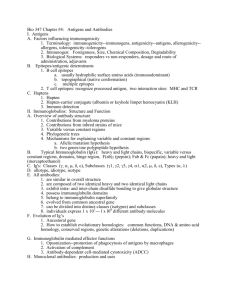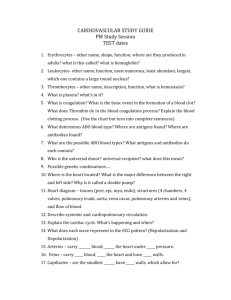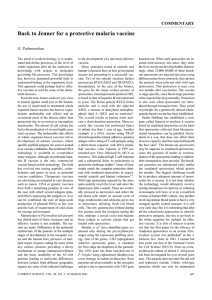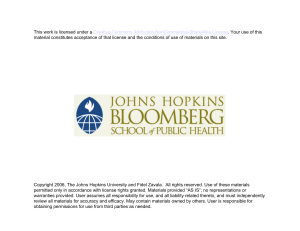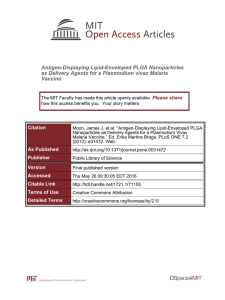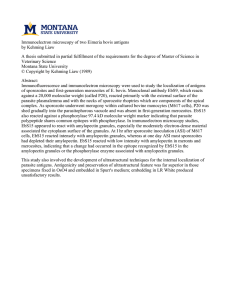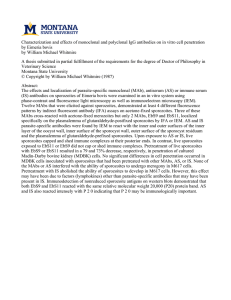malaria
advertisement
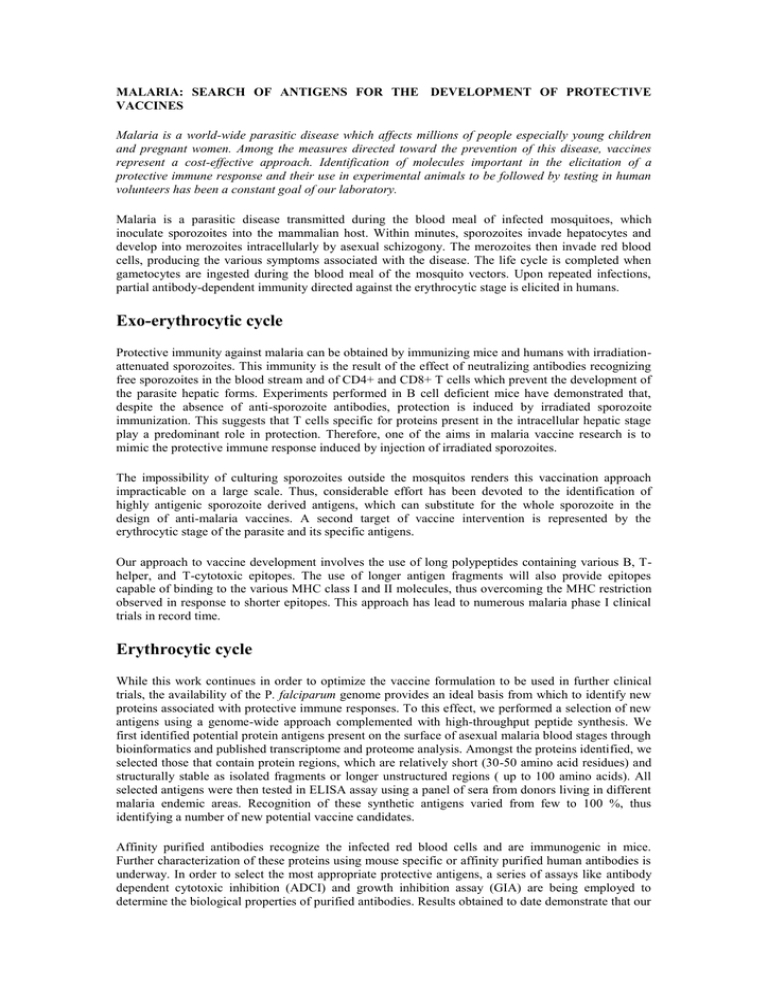
MALARIA: SEARCH OF ANTIGENS FOR THE DEVELOPMENT OF PROTECTIVE VACCINES Malaria is a world-wide parasitic disease which affects millions of people especially young children and pregnant women. Among the measures directed toward the prevention of this disease, vaccines represent a cost-effective approach. Identification of molecules important in the elicitation of a protective immune response and their use in experimental animals to be followed by testing in human volunteers has been a constant goal of our laboratory. Malaria is a parasitic disease transmitted during the blood meal of infected mosquitoes, which inoculate sporozoites into the mammalian host. Within minutes, sporozoites invade hepatocytes and develop into merozoites intracellularly by asexual schizogony. The merozoites then invade red blood cells, producing the various symptoms associated with the disease. The life cycle is completed when gametocytes are ingested during the blood meal of the mosquito vectors. Upon repeated infections, partial antibody-dependent immunity directed against the erythrocytic stage is elicited in humans. Exo-erythrocytic cycle Protective immunity against malaria can be obtained by immunizing mice and humans with irradiationattenuated sporozoites. This immunity is the result of the effect of neutralizing antibodies recognizing free sporozoites in the blood stream and of CD4+ and CD8+ T cells which prevent the development of the parasite hepatic forms. Experiments performed in B cell deficient mice have demonstrated that, despite the absence of anti-sporozoite antibodies, protection is induced by irradiated sporozoite immunization. This suggests that T cells specific for proteins present in the intracellular hepatic stage play a predominant role in protection. Therefore, one of the aims in malaria vaccine research is to mimic the protective immune response induced by injection of irradiated sporozoites. The impossibility of culturing sporozoites outside the mosquitos renders this vaccination approach impracticable on a large scale. Thus, considerable effort has been devoted to the identification of highly antigenic sporozoite derived antigens, which can substitute for the whole sporozoite in the design of anti-malaria vaccines. A second target of vaccine intervention is represented by the erythrocytic stage of the parasite and its specific antigens. Our approach to vaccine development involves the use of long polypeptides containing various B, Thelper, and T-cytotoxic epitopes. The use of longer antigen fragments will also provide epitopes capable of binding to the various MHC class I and II molecules, thus overcoming the MHC restriction observed in response to shorter epitopes. This approach has lead to numerous malaria phase I clinical trials in record time. Erythrocytic cycle While this work continues in order to optimize the vaccine formulation to be used in further clinical trials, the availability of the P. falciparum genome provides an ideal basis from which to identify new proteins associated with protective immune responses. To this effect, we performed a selection of new antigens using a genome-wide approach complemented with high-throughput peptide synthesis. We first identified potential protein antigens present on the surface of asexual malaria blood stages through bioinformatics and published transcriptome and proteome analysis. Amongst the proteins identified, we selected those that contain protein regions, which are relatively short (30-50 amino acid residues) and structurally stable as isolated fragments or longer unstructured regions ( up to 100 amino acids). All selected antigens were then tested in ELISA assay using a panel of sera from donors living in different malaria endemic areas. Recognition of these synthetic antigens varied from few to 100 %, thus identifying a number of new potential vaccine candidates. Affinity purified antibodies recognize the infected red blood cells and are immunogenic in mice. Further characterization of these proteins using mouse specific or affinity purified human antibodies is underway. In order to select the most appropriate protective antigens, a series of assays like antibody dependent cytotoxic inhibition (ADCI) and growth inhibition assay (GIA) are being employed to determine the biological properties of purified antibodies. Results obtained to date demonstrate that our bioinformatics/chemical synthesis approach can lead to the identification of new proteins that can be targets of potential vaccines and/or drugs in a very short time frame (2 years, see reference Olugbile et al.). In addition, the antigen selection mechanism is of general application, and can be applied to any other pathogen where protection is mediated by antibodies. Malaria Cycle


